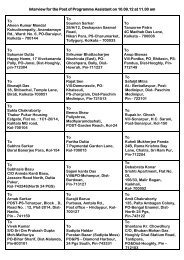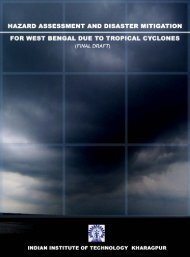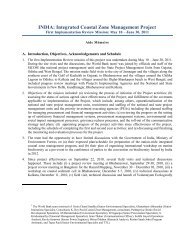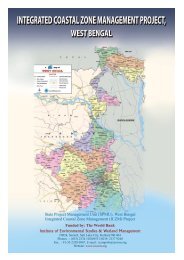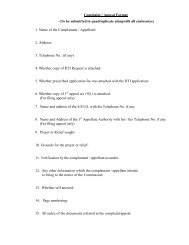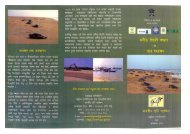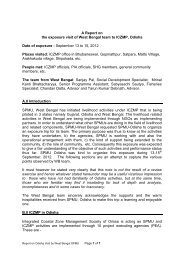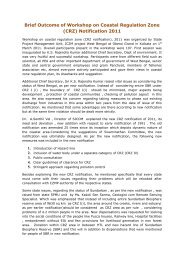BID Document for Guest House with Boundary Wall.pdf - Integrated ...
BID Document for Guest House with Boundary Wall.pdf - Integrated ...
BID Document for Guest House with Boundary Wall.pdf - Integrated ...
Create successful ePaper yourself
Turn your PDF publications into a flip-book with our unique Google optimized e-Paper software.
the worst weather and flooding conditions, the existing pipeline / utilities remain stable and shall neither<br />
become undermined nor have the tendency to slide towards the trench.<br />
2.1.10 Shifting of Underground Services:<br />
Any or all the existing underground utility lines such as telephone cables etc. which may be encountered<br />
during the progress of work shall have to be very carefully supported and maintained.<br />
In case any of the existing utility lines is to be shifted or attended in any fashion the Contractor shall intimate<br />
the Department. The Contractor shall also get the necessary alteration done by negotiation <strong>with</strong> the concerned<br />
organization to the satisfaction of the Engineer-in-Charge. No attempt should be made on the part of the<br />
Contractor to shift or alter any of the utility lines <strong>with</strong>out specific instruction from Engineer-in-Charge.<br />
2.1.11 Precautions Against Floatation:<br />
Contractor shall check if up-floating danger is present in open trench and then shall take appropriate measures<br />
to prevent up floating. Such as applying soil dams and de-watering of trench or temporary filling of water into<br />
the line (in exceptional cases).<br />
In some stretches, if up floating of the pipeline after back filing is reckoned <strong>with</strong>, such stretches shall be<br />
indicated in the drawings. If such stretches requiring negative buoyancy are encountered during construction,<br />
which are not indicated in drawing but required in the opinion of the Engineer-In-Charge, Contractor shall<br />
provide necessary measures to prevent buoyant effect in consultation <strong>with</strong> Engineer-In-Charge. Floating of the<br />
pipeline can be prevented by providing sufficient overburden or by providing sufficient dead weight by means<br />
of anchor block or by applying a continuous concrete coating around the pipe to provide the desired weight.<br />
Whatever continuous concrete coating is used, it shall con<strong>for</strong>m to the provision of relevant specifications<br />
unless indicated otherwise in the drawing.<br />
2.1.12 Night Caps:<br />
At the end of each day’s work or every time when joining operations are interrupted, the open ends of pipes<br />
shall be capped <strong>with</strong> securely closed metal cap or plug as approved by the Engineer-In-Charge so as to<br />
prevent the entry of dirt, dust, water or any <strong>for</strong>eign matter into the pipeline. These covers shall not be removed<br />
until the work is to be resumed.<br />
2.1.13 Closing Lengths:<br />
Pipes which are required to be cut to from closing pieces in any portion of the pipelines or to terminate in<br />
chambers / manhole or other parts of the works shall not be cut until after all adjacent pipes and fitting have<br />
been installed and joined.<br />
The Contractor shall determine the length of each closing piece, the required angle and shape of the same,<br />
which shall be brought to the notice of the Engineer-In-Charge <strong>for</strong> approval. The cut shall be neatly per<strong>for</strong>med<br />
and the end of the pipe shaped and trimmed so as to ensure an accurate joint or termination as the case may be<br />
any damage to sheathing, coating or lining shall be made good.<br />
2.2 Laying of D.I. Pipes<br />
The laying of D.I. pipes shall con<strong>for</strong>m to the guidelines mentioned herein / relevant clauses of concerned IS<br />
code of practice.<br />
2.2.1 Lowering of D.I. pipe:<br />
Proper instruments, tools and facilities satisfactory to the Engineer-In-Charge shall be provided and used by<br />
the Contractor <strong>for</strong> the safe and convenient per<strong>for</strong>mance of the work. All pipes, fittings, and valves shall be<br />
carefully lowered into the trench, piece by means of crane derrick, rope or other suitable tools or equipment,<br />
in such a manner as to prevent damage to pipes, valves, fittings, etc. and protective coatings and linings.<br />
Under no circumstances shall materials be dropped or dumped into the trench. If damage occurs to any pipe,<br />
fitting, valve or accessory in handling, the damage shall be immediately brought to the Engineer-In-Charge’s<br />
attention. The Engineer-In-Charge shall prescribe corrective repairs or rejection of the damaged items. Pipes<br />
over 250 mm diameter shall be handled and lowered into trenches <strong>with</strong> the help of crane.<br />
2.2.2 Cleaning of D.I. Pipes and Fitting:<br />
All lumps, blisters, and excess coating material shall be removed from the socket and spigot end of each pipe.<br />
The outside of the spigot and inside of the socket shall be wiped clean. Dry and free from oil and grease<br />
be<strong>for</strong>e the D.I. pipe is laid.<br />
2.2.3 Laying:<br />
87






